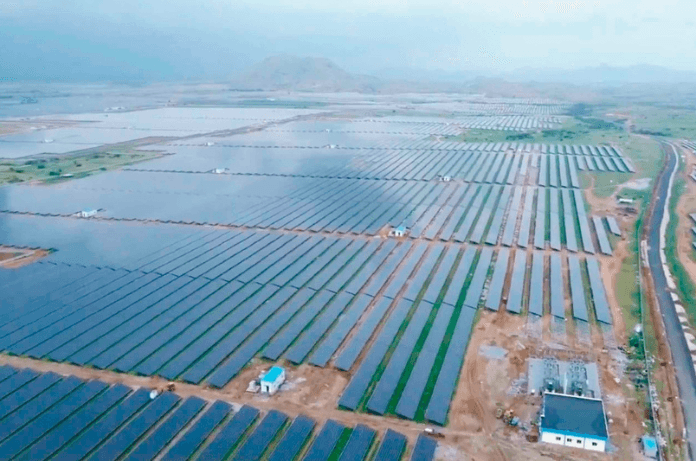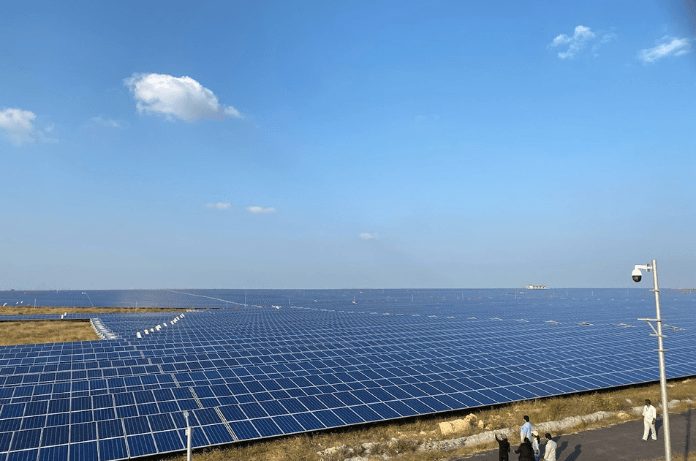India has made significant strides in the realm of renewable energy over the last decade, aiming to balance its economic growth with environmental sustainability. As one of the world’s leading countries in solar energy production, India has established itself as a pioneer in the renewable energy sector, setting ambitious goals for reducing carbon emissions. Among its many initiatives, India’s construction of the Pavagada Solar Park stands out as a beacon of its commitment to a sustainable future.
Overview of Pavagada Solar Park
- Project Name: Pavagada Solar Park is also known as Shakti Sthala
- Location: Pavagada Solar Park is located in Tumkur district in Karnataka, India, covering a massive area of around 13,000 acres.
- Capacity: The mega solar park has an installed capacity of 2,050 MW, making it the 1st largest in the world. It’s designed to supply power to over 700,000 households.
- Development: The project was developed by the Karnataka Solar Power Development Corporation Limited (KSPDCL), a joint venture between Solar Energy Corporation of India (SECI) and Karnataka Renewable Energy Development Ltd (KREDL).
- Investment: This project was developed with an estimated investment of INR 1500 Crores
- Timeline: The solar park was conceptualized in 2015 and reached full operational status by 2019, illustrating India’s fast-tracking of renewable projects.
- World’s largest solar park: With the commissioning of the last 100 MW solar project by SB Energy in December 2019, Pavagada Solar Park became fully operational and recognized as the world’s biggest solar park by then. Later, it lost its number 1 position to the 2,245 MW Bhadla Solar Park in Rajasthan and the 2,200 MW Huanghe Hydropower Hainan Solar Park in China and became the world’s 3rd largest solar park.

Unique Features of the Pavagada Solar Park
- Land Lease Model:
Unlike many other large infrastructure projects, Pavagada Solar Park operates on a land lease model.
Farmers lease their land to the government for solar energy production, receiving regular rental income without selling their land.
This innovative model has addressed local resistance and provided stable income to over 2,300 landowners in the region.
- Cost-Effective Energy Production:
The solar park has been able to produce energy at a competitive tariff of approximately INR 2.8 per unit, making solar energy more affordable in comparison to traditional fossil fuels.
The availability of abundant sunlight in the region and the scale of the project have helped in achieving economies of scale, reducing per-unit costs significantly.
- Solar Plant Clustering:
The park uses a cluster-based development approach, dividing the 13,000 acres into smaller units for solar power plants.
This approach allows for better management and streamlined operations, reducing the complexity of managing a project of this scale.
- Environment-Friendly Design:
The park is designed to minimize ecological disruptions, preserving the existing water bodies and topographical features.
By leveraging unused, arid land, it avoids deforestation or displacement of residents, making it a model of sustainable development.
India’s Broader Renewable Energy Goals
India’s journey toward renewable energy is shaped by ambitious targets and international commitments, aligning with global efforts to combat climate change.
- National Solar Mission:
Launched in 2010, the Jawaharlal Nehru National Solar Mission (JNNSM) aimed to achieve 100 GW of solar power by 2022. While India missed the target, it has made considerable progress, positioning itself as the fourth-largest solar market in the world.
The mission has been a catalyst for large-scale solar parks like Pavagada, the world’s 3rd largest solar park, Bhadla Solar Park in Rajasthan – the world’s largest solar park, and Rewa Ultra Mega Solar Park in Madhya Pradesh.
- Commitment to Climate Goals:
At the COP21 Paris Agreement in 2015, India committed to reducing its carbon emissions intensity by 33-35% by 2030 compared to 2005 levels.
As part of the updated Nationally Determined Contributions (NDCs), India aims to increase the share of non-fossil fuel energy capacity to 50% by 2030, with a significant focus on solar energy.
- International Solar Alliance (ISA):
India co-founded the International Solar Alliance (ISA) with France in 2015, aiming to promote solar energy use in 121 countries lying between the Tropics of Cancer and Capricorn.
The ISA serves as a platform for collaboration, financing, and capacity-building in solar energy deployment globally, with India playing a central role in fostering international partnerships.
Impact of the Pavagada Solar Park
- Boosting Karnataka’s Energy Supply:
Karnataka has emerged as one of India’s leading states in solar power, largely due to Pavagada Solar Park.
The state has a total installed solar capacity of over 7,000 MW, with Pavagada contributing a significant share, reducing the state’s dependence on coal-based power plants.
- Job Creation and Economic Upliftment:
The construction and operation of the solar park have created thousands of jobs, particularly in rural areas.
Beyond direct employment, the project has stimulated economic activity in ancillary industries, including maintenance, logistics, and solar panel manufacturing.
- Reduction in Carbon Emissions:
Pavagada Solar Park helps reduce CO2 emissions by approximately 1.8 million tons per year, equivalent to taking over 400,000 cars off the road annually.
The shift to solar energy has contributed significantly to improving air quality and reducing the health burden associated with coal-based power plants.
Challenges in the Journey
While Pavagada Solar Park represents a major leap forward, India’s push for renewable energy faces several challenges:
- Grid Integration:
The variability of solar power, especially during cloudy days or at night, poses challenges for integrating solar energy into the national grid.
Investments in energy storage technologies, such as batteries, and grid modernization are needed to ensure a stable supply of electricity.
- Land Acquisition Hurdles:
Despite the success of the land lease model at Pavagada, land acquisition remains a major hurdle for similar projects in other regions, where resistance from local communities can delay development.
- Financing and Investment Risks:
Large-scale solar projects require substantial upfront investment. Attracting private investors and maintaining long-term financial stability can be challenging, especially in a competitive energy market.
India has seen fluctuations in government policies and tariffs that can create uncertainty for investors.
The Road Ahead for India’s Renewable Energy Ambitions
- Scaling Up Solar Infrastructure:
With the success of Pavagada Solar Park, India is looking to replicate similar models in other states, including mega solar projects in Gujarat, Rajasthan, and Andhra Pradesh.
India’s Ministry of New and Renewable Energy (MNRE) aims to reach 300 GW of solar capacity by 2030, further solidifying its leadership in the global renewable energy market.
- Focus on Hybrid Energy Models:
To address the intermittency of solar power, India is exploring hybrid renewable energy models, combining solar with wind and hydropower.
Hybrid parks in states like Gujarat are designed to provide a more consistent energy output, reducing strain on the power grid.
- Investment in Solar Manufacturing:
The government’s Production-Linked Incentive (PLI) scheme aims to boost domestic manufacturing of solar modules, cells, and wafers, reducing dependence on imports.
By promoting local manufacturing, India not only aims to strengthen its solar supply chain but also create additional employment opportunities.
Community Engagement and Awareness:
To ensure the success of large-scale solar projects, community involvement is critical. Building awareness about the benefits of solar energy and empowering local stakeholders can create more acceptance for such projects.
Training programs and workshops are being conducted to upskill local populations for jobs in the renewable energy sector.
Overall, India’s efforts in building the world’s 1st largest solar park at Pavagada exemplify its commitment to transforming its energy landscape. By embracing innovative models, addressing challenges, and setting ambitious targets, India is paving the way for a sustainable future, not just for itself but also as a leader in the global renewable energy transition.
The success of such projects highlights the potential of solar energy to provide clean, reliable power while uplifting local communities and contributing to global climate goals.
As India continues to invest in renewable energy, the Pavagada Solar Park stands as a symbol of its vision for a greener tomorrow.

